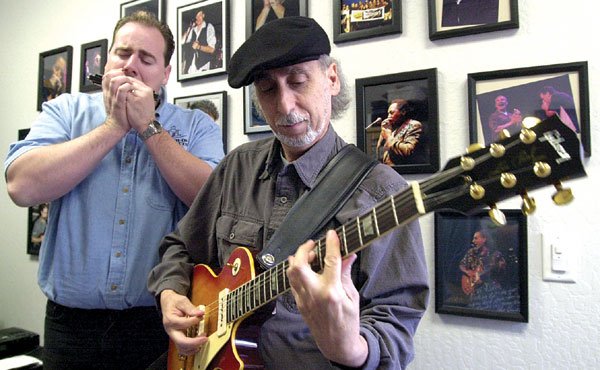It seems that every musician in the world of blues music is
connected to each other in some way. Maybe there’s a gravitational
pull, an unseen force that pulls these musicians toward one
another, or maybe it’s the deep respect blues musicians seem to
have for each other that isn’t seen in some other genres of
music.
Or maybe it’s the music itself.
For David Barrett, a musician who grew up in Morgan Hill playing
instruments like the saxophone and trumpet before he first touched
the harmonica and fell in love with blues, getting his foot in the
door with local blues players took a lot of work, but now it’s
taken him a long way.
It seems that every musician in the world of blues music is connected to each other in some way. Maybe there’s a gravitational pull, an unseen force that pulls these musicians toward one another, or maybe it’s the deep respect blues musicians seem to have for each other that isn’t seen in some other genres of music.
Or maybe it’s the music itself.
For David Barrett, a musician who grew up in Morgan Hill playing instruments like the saxophone and trumpet before he first touched the harmonica and fell in love with blues, getting his foot in the door with local blues players took a lot of work, but now it’s taken him a long way.
Barrett started he quest to become a great harmonica player by going to a one of the Bay Area’s best-known harmonica players, Gary Smith.
“I asked Gary Smith for lessons and he said no,” said Barrett, who wouldn’t give up that easy. He returned to Smith again and pleaded for a chance to learn, promising to be a great student, and Smith gave in.
Barrett also wanted to get involved with John Garcia, a local blues guitarist from Gilroy who had played with all of the great blues musicians of the era, including John Lee Hooker.
“When I was 18 years old, I did a demo with a local blues guitarist and singer that is starting to make a name for himself, Shane Dwight. I think we were going to do a gong show, and I waited after a class of John’s,” Barrett said when he remembered trying to get Garcia to come to their show and listen to their demo tape. “When John was packing up and leaving I was kind of walking up behind him, and I came up to him and he looked at me like I was a mugger. I asked him to go to the gong show and to listen to our tape. I introduced myself, and I think I called him Mr. Jerry Garcia (of the Grateful Dead). … I remember going away thinking (smacking his head).”
Twelve years have gone by since that meeting, but Garcia still has that demo tape, and over the years he and Barrett became friends and started playing together from time to time. And a few years ago, Barrett, who has put his blues knowledge into a career of music education, opened up the School of Blues in South San Jose, and he said he had to have Garcia helping teach music there.
“When I started making this a focus, I knew exactly who I wanted,” Barrett said. “I wanted John on the guitar.”
The school, which opened in March of 2002, now has more than 100 students taking lessons from six instructors of blues guitar, harmonics, drums and singing.
“We’re growing slowly,” Barrett said. “The hard part is we’re very specialized in one subject, which is good but also bad.”
Garcia, 55, who has been teaching guitar for 30 years, also has an interesting story on how he was pulled into the world of blues and how he was given the opportunity to play music with his heroes.
Garcia, a native Gilroyan, was playing with Smith in the 1970s while he was taking music classes at Gavilan College before he had a chance meeting with John Lee Hooker that forever changed his life.
“I came up listening to surf music and some of the pop and rock and roll tunes of the time,” Garcia said. “It was rock and it was blues and it was everything that was happening. As long as it sounds good.”
But friend Billy Vega was the main reason Garcia ever met up with Hooker and began playing lead guitar for the band.
“Billy always had these tall tales, you didn’t know whether you could believe him or not, but he kept saying that he knew John Lee and he was moving to Gilroy,” Garcia remembered. “He took me over to the house and he introduced me to him. … He actually lived in John’s basement for a while.”
Garcia was shocked that Vega, a free spirit who apparently was a roadie for the band at one time, actually knew Hooker. But that connection led to a career that most can only dream about.
“It opened a door because it gave me a chance to play with people I had only read about,” he said. “You can’t get that in any school, that type of education. I really feel blessed I go to do so many things and with so many people through the years.”
Garcia played with Hooker until the 1980s, and now splits his time teaching and performing with his band, as a solo act with an album coming out in a few months and with the School of Blues band.
And the School of Blues is putting out more than just new blues musicians, it’s also becoming a ground for new music. Working with one another has led Barrett and Garcia to decided to put out an album showcasing their talents. The album is one in a long list for Garcia, who has two solo albums and has performed on countless other records, but it is a first for Barrett.
“I focus mainly on teaching,” Barrett said. “It was time for me to do an album. I’ve never done one. I’d written books.”
The album, called “Serious Fun,” is available at Music for a Song, Porcella’s Music, California Music Company and at www.schoolofblues.com. The duo will also perform with a band for a CD release party Saturday night at the Strand Theater in Gilroy.
For Barrett, producing an album meant more than just putting some of his work on a CD. It meant showing that he was more than just a music teacher.
“My main reason for doing the album is that I promote myself as the world’s most published author of blues harmonica,” said Barrett, who said one of his students called him the Kingpin of Blues Harmonica Without an Album. “It’s something I needed to do. I had to dish it out and just to play some music, to show the world what’s in our brains.”
Barrett began work on the album as a solo venture, but after sitting down with Garcia and talking about some of his ideas, Barrett and Garcia decided that it would be better to do an album together with Barrett’s harmonica standing out while Garcia would keep the rhythm.
“I couldn’t make it the way it turned out without John,” Barrett said. “You know what they say, if you want to sound good, surround yourself with good players. To be able to back a harmonica up and make it sound good is a key thing – It’s an important thing.”
The album is 80 percent original music written by Barrett and Garcia. The two hope it will not only sell well on its own but also bring more attention to the music school. They also are discussing touring the country to teach blues improvisation next year and have signed on with Mel Bay publishing to write a book about blues music that is planned to be released in about three years. The book will be called “Blues Improvisation: Form and Groove.”
“It’ll be a pretty mammoth book,” Barrett said. “It will teach you everything you need to know about playing the blues except for the practice.”
For more information on the School of Blues, visit www.schoolofblues.com.












